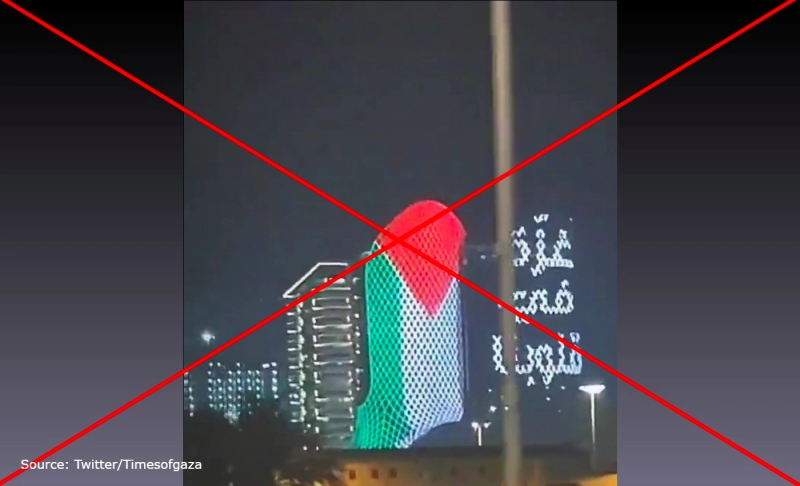By: Ishita Goel
December 13 2022
Partly True: By projecting the text “Gaza is in our hearts” on a building, Qatar is supporting Palestine amid the World Cup.

The Verdict Partly_True
Qatar does support Palestine, but an August 2022 video is being shared to claim the country is making a statement during the ongoing world cup.
Context
The 2022 FIFA World Cup kicked off on November 20 in Qatar, the first-ever world cup held in an Arab country. A video showing a building lit with the words "Gaza is in our hearts" in Arabic (غزة في قلوبنا) went viral on social media. A Facebook user captioned it, "Thank you, Qatar for reminding the world to stand with Palestine." The posts had the tags "#Gaza #Palestine #QatarWorldCup2022," which could imply Qatar was making a statement supporting Palestine during the tournament. However, this video is dated and unrelated to the ongoing world cup.
In Fact
On conducting a reverse image search and applying keywords like "Qatar" and "Gaza is in our hearts," we found the video was from August 2022. Qatar-based Doha News tweeted on August 9, 2022, "The Al Jaber Twin towers in Lusail Marina light up with the Palestinian flag and a message that reads 'Gaza in our hearts.'" Similarly, on August 10, the Middle East Monitor (MEMO) reported an article with the headline "Qatar's Al-Jabir Towers light up with Palestinian flag" and published the building's image with the tag Gaza in our hearts. It stated the Doha towers were illuminated in solidarity with Gaza following an Israeli attack starting August 6. Reliefweb, a service of the United Nations Office for the Coordination of Humanitarian Affairs (OCHA), reported that Israeli forces conducted a military attack on the Gaza strip for three days. Around 31 Palestinians died, and about 228 were injured.
Israel-Palestine conflicts root back to the late 19th and early 20th centuries. For years, countries have joined in to support Palestine. According to the United Nations, 139 states provide bilateral recognition to Palestine And record states Qatar gave it recognition in 1988.
On November 29, 2022, Qatar's Ministry of Foreign Affairs tweeted the highlights of Qatari support towards Palestine since 2015 and captioned it, "Over the years, Qatar has been supporting the steadfastness of the brotherly Palestinian people in the face of the Israeli occupation." The image of the highlights included how Qatar has supported various sectors in Palestine. This tweet was posted on the International Day of Solidarity with the Palestinian People, celebrated every November 29. Qatar also joined the celebration held at the U.N. Headquarters in New York.
Doha News reported Qatar voted in favor of a draft resolution titled "Israeli practices affecting the human rights of the Palestinian people in the Occupied Palestinian Territory, including East Jerusalem." Qatar's Amir Sheikh Tamim bin Hamad Al Thani has warned that there shall be "tensions and instability" in the middle east until Israel's conflicts against Palestine persist.
No reports indicate that Qatar supports Palestine or any national team in the World Cup. Support towards Palestine is a global cause, and there is no link to the ongoing World cup. There are instances of Qatari people showing their support, but the government is not especially supporting them.
FIFA has cut a deal with Qatar to permit Israelis and Palestinians to attend 2022 FIFA World Cup on special charter flights from Tel Aviv "to improve relations across the Middle East." Qatar, which has no relations with Israel and supports the Palestinian cause for statehood, insisted that Palestinians be allowed to travel with Israelis as a condition for allowing direct flights. Many encounters between both countries' journalists and fans have gone viral on social media. Neither the Israel national football team nor Palestine national football team participated in the 2022 FIFA tournament.
The Verdict
This video on Qatar's support for Palestine dates back to August 2022, following an Israeli military offensive in Gaza. Although Qatar has supported Palestine for decades, the administration is not intentionally giving pro-Palestinian messages during the world cup. Therefore, we have marked the claim as misleading.


